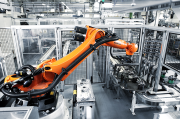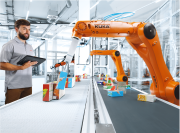 Since the First Industrial Revolution, automation has boosted output, productivity, employment and national wealth. Robots and advanced automation, including artificial intelligence, have never been more accessible than they are now. Arguably, they have never been more vital, either.
Since the First Industrial Revolution, automation has boosted output, productivity, employment and national wealth. Robots and advanced automation, including artificial intelligence, have never been more accessible than they are now. Arguably, they have never been more vital, either.
It is a message that bears repeating: automation boosts productivity.
According to a 2015 London School of Economics report1, which studied the impact of robotics on productivity across 14 industries in 17 countries between 1993 and 2007, robots raised those countries’ average GDP growth rates by about 0.37 percentage points and productivity growth by about 0.36 percentage points respectively. Small numbers – but they add up. Over the 14-year period, additional growth amounted to 12% of total GDP growth and 18% of labour productivity growth in the countries studied.
McKinsey is even more positive. It believes that “automation could raise productivity growth globally by 0.8 to 1.4 percent annually”2. If that is the impact across the whole economy, the transformation that could be achieved by individual businesses should be similar, and in many cases greater.
The proof is already here
There are ample examples of companies, especially SMEs, transforming their competitiveness, quality, productivity and profitability by investing in appropriate automation. This publication highlights several businesses for whom automation has been transformational, including cider brewers Thatchers, who cut forklift truck movements by 50% while improving consistency and output in its palletization-depalletization cell, and Odyssey Studios in Limerick and Dublin, Ireland, which automated the production of scaled and full-size models for film, theatre and TV, enabling it to win bigger contracts across the world.
On a larger scale, UK automotive has invested the most of all industrial sectors in automating production lines but headcount, in most cases, has increased3 – showing that robots do not always mean job losses. ZND in Rotherham, manufacturers of temporary fencing, installed robots, increased capacity and sales and hired more people in sales and engineering (see more on page 36).
 Automation: an opportunity for SMEs to grasp
Automation: an opportunity for SMEs to grasp
In 2018, NatWest-sponsored research by Cebr4 said that SMEs could add up to £57bn a year to the UK’s economy if they were as productive as similar-sized enterprises in Germany. The research shows UK SME employees generate £147k worth of output per year on average – less than half that of their German counterparts’ £335k/worker/year.
Automation can help transform even the very smallest companies. A UK business with 10 employees could increase annual turnover by £1.9m if they worked at the same productivity level as a German business; the figure rises to £4.7m for businesses with 25 employees5.
Small is beautiful – and productive
Automation need not involve large pieces of machinery or large investment. KUKA’s KR3 Agilus robots have payloads of just 3kg and operate in cells just 600 x 600mm. It is ideal for businesses assembling small components that are tight on available space. Even more simply, a palletization cell can free up staff from repetitive manual labour to conduct more productive tasks, while a robot palletizes perfectly, time after time, 24/7 and year-round. It never gets bored or takes time off sick.
Technological advance under the heading of “Industry 4.0” has been a topic of discussion
since 2011 when Germany’s federal government launched the term. It is high time it moved off the lower reaches of the agenda and onto the shopfloor. Although automation and Industry 4.0 are not the same thing, an automated connected process is a big part of it.
Archie McPherson, CEO of High Value Manufacturing Catapult at Warwick Manufacturing Group, asks the simple question: “if you don’t automate, where will you be in five years’ time?”
Change is unavoidable: seize the time
If that question had been posed five years ago, it is doubtful that anyone would have forecast what has happened this year: Covid-19 has dominated 2020. The pandemic has shown the vulnerability of globe-spanning supply chains and has stimulated discussion of reshoring or “nearshoring” – bringing manufacturing back from low-cost countries and closer to the marketplaces. Controlling labour costs and maintaining competitiveness requires automation. Covid-19 has accelerated what was a rising trend; Richard Wilding OBE, Professor of Supply Chain Strategy, Cranfield University, said that discussions were already under way.
“We were starting to see increases in nearshoring; the current crisis has created the ultimate “burning platform” and we have been seeing, in some organizations, the equivalent of five years of implementation within a three-month period,” he says6.
Breakthrough technologies like 3D printing and automation of customised production are in their infancy. This provides British and Irish businesses with a golden opportunity to leapfrog a couple of generations of automation and catch up with Germany and other competitors – but it must be done the right way. Wasting money on confusing and expensive “tool proliferation” and what McKinsey describes as the “IT fallacy” – the idea that sustainable automation can be driven by IT alone – must be avoided.
With a range of products that extends from benchtop models like the KR3 Agilus to the 1300kg payload KR1000 Titan and its system partner program, KUKA is ideally placed to provide the right tools and advice to automation newcomers and improvers alike.


